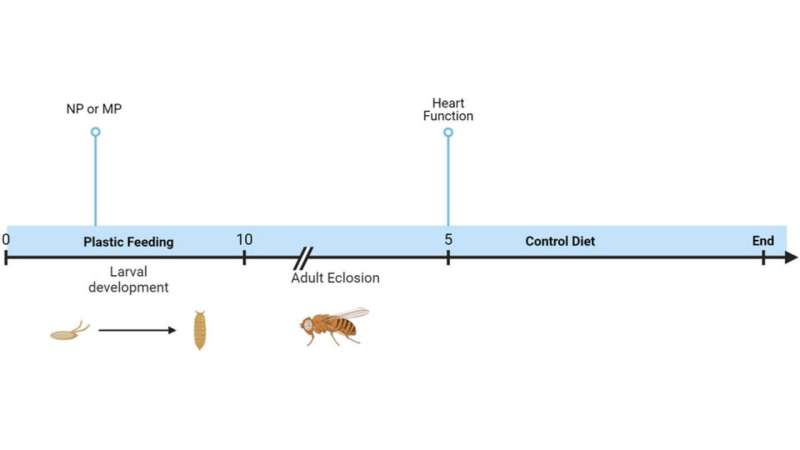Title: Ingestion of Micro- and Nanoplastics Alters Heart Size and Function in Drosophila

August 23, 2024 feature
This article has been reviewed according to Science X's editorial process and policies. Editors have highlighted the following attributes while ensuring the content's credibility:
- fact-checked
- trusted source
- proofread
by Stephanie Baum , Phys.org
Plastics are ubiquitous in products we use every day, and recent studies have begun to reveal the effects of micro- and nanoplastics (MPs and NPs) on the health of humans and animals.
Much research on the health effects of MPs and NPs to date has focused on marine life, especially fish. A few early studies have investigated possible toxic effects of plastics on terrestrial species such as birds, earthworms, insects, humans and other mammals, but myriad specifics remain unknown.
A team of researchers from Iowa State University, using fruit flies (Drosophila melanogaster), has now made the first examination of the effects of MP and NP toxicity on the heart. The team's work is published in a Brief Research Report in Frontiers in Toxicology.
In 2017, a study by Geyer et al estimated that approximately 8,300 million metric tons of plastic had been produced since 1950; that more than 4,900 million metric tons of that plastic had ended up in landfills or elsewhere in the environment; and that with no change to production or waste management levels, that number could increase to 12,000 metric tons by 2050.
According to more recent research, 'Approximately 36 million tons of waste plastics are generated in the United States each year, most of which are discharged into the environment and end in landfills.'
Against this background, and with heart disease as the top cause of death worldwide, understanding the effects of MP and NP exposure on the heart becomes urgent.
Drosophila hearts and vertebrate hearts are similar with respect to functional and genetic changes during development and aging. For this new study, the researchers obtained wild-type Drosophila fly larvae and divided them into a control group and two test groups.
They fed all the flies a diet of cornmeal from the beginning of their development until they reached maturity (pupation). Flies in the two test groups received cornmeal to which the researchers added polystyrene MPs (larger than 100 nm and smaller than 5 mm) or NPs (smaller than 100 nm).
Five days after the flies hatched, the researchers collected approximately 15 flies of each sex from each of the two test groups and the control group. The team anesthetized the flies, dissected their beating hearts, and recorded high-speed video at over 200 frames/second for analysis.
Among the notable results, the analysis indicates that plastic exposure produces different results in males and females. The heart rates of female flies exposed to both MPs and NPs decreased 13%, while their heart periods (time between the beginning of a heartbeat and the beginning of the next heartbeat) increased correspondingly. Male flies did not exhibit this change, but males fed MPs exhibited greater variability than those fed NPs and those in the control group.
In female flies fed NPs, heart size (diastolic diameter) increased, and diastolic intervals increased in females fed both MPs and NPs. Meanwhile, heart sizes of male flies fed both sizes of plastic exhibited significant changes to diastolic and systolic diameters.
Furthermore, the researchers write, 'Unlike females, male flies also see changes to Systolic Interval (SI) Time and fractional shortening. Total SI time is reduced by 40% in flies exposed to MPs while female flies see no change. Finally, males exposed to NPs experience an 11% reduction in fractional shortening. This phenomenon is unique to males, as females see no change to fractional shortening following dietary exposure to either plastic size.'
The researchers note that they had initially hypothesized that the changes they recorded might have resulted from MPs and NPs actually creating a physical barrier to normal heart development. They also believe that 'molecular interactions between the plastics and the heart itself' are responsible for the sexually dimorphic changes they observed, especially the differences in male and female heart sizes.
However, they acknowledge, 'The true mechanism behind these observed changes is unknown, and so further research is needed to identify if exposure to MPs and NPs interacts with any mammalian conserved genes which may lead to cardiac dysfunction.'
They also suggest that further research could include a variety of ingestible plastic shapes, and that further research should also focus on pinpointing the specific molecular changes causing the observed functional disorders.
'The data from this study can inform the field on potential changes to other terrestrial organisms and opens the door to future studies investigating the molecular mechanism behind these changes and underscores the importance of research in plastic on both sexes,' the team concludes.
More information: Alyssa M. Hohman et al, The heart of plastic: utilizing the Drosophila model to investigate the effects of micro/nanoplastics on heart function, Frontiers in Toxicology (2024). DOI: 10.3389/ftox.2024.1438061
© 2024 Science X Network




